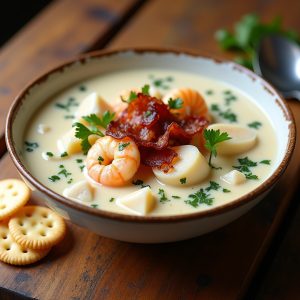
AI generated image
Chef's Tip
Add the seafood in stages based on cooking time, starting with cod, then scallops, and finally shrimp. This prevents overcooking and ensures each type of seafood maintains its ideal texture in the finished chowder.
Instructions
- In a large Dutch oven or heavy pot, cook bacon over medium heat until crisp, about 5-6 minutes. Remove with a slotted spoon and set aside, leaving the rendered fat in the pot.
- Add butter to the pot. Once melted, add onions and celery, cooking until softened, about 5 minutes. Add garlic and cook for 30 seconds until fragrant.
- Sprinkle flour over the vegetables and stir constantly for 1-2 minutes to cook the flour without browning.
- Gradually whisk in clam juice and fish stock, stirring constantly to prevent lumps from forming.
- Add bay leaf, thyme, and potatoes. Bring to a simmer, then reduce heat to medium-low. Cook until potatoes are just tender, about 15 minutes.
- Stir in heavy cream and bring back to a gentle simmer.
- Add cod pieces and cook for 2 minutes, then add scallops and cook for 2 more minutes.
- Finally, add shrimp and cook until all seafood is just cooked through, about 2-3 minutes more. The cod should flake easily, and shrimp should be pink and opaque.
- Remove from heat and discard bay leaf. Season with salt and pepper to taste.
- Stir in half the cooked bacon and half the parsley.
- Let the chowder rest for 5 minutes before serving to allow flavors to meld.
Plating
Ladle the hot chowder into warm bowls. Garnish each portion with remaining bacon bits and fresh parsley. Serve with oyster crackers on the side for added texture.
Storage & Reheating
Store cooled chowder in an airtight container in the refrigerator for up to 2 days. Reheat gently over medium-low heat, stirring occasionally and taking care not to boil, which can cause the cream to separate and the seafood to become tough.
About This Recipe
This chowder represents the quintessential Boston seafood experience, drawing on the bounty of New England's coastal waters. The combination of multiple seafood varieties creates layers of flavor and texture. Unlike the sometimes excessively thick restaurant versions, this home-adapted recipe balances creaminess with a more soup-like consistency that allows the fresh seafood flavors to shine.
